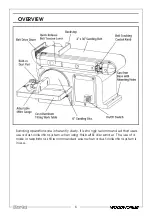
4
15.
NEVER
operate machine while under the influence of drugs, alcohol or any
medication.
16.
NEVER
leave machine running unattended. Turn power off. Do not leave
the machine until it comes to a complete stop.
17.
NEVER
force the machine, it will do a better and safer job at the rate for
which it was designed.
18.
NEVER
use power tools in damp or wet locations or expose them to rain.
Do not use in an explosive atmosphere (around paint, flammable liquids
etc.). Avoid dangerous environments.
19. If the tool begins to make an abnormal noise, or produce excessive
vibrations, smoke or burning odour, turn the tool off immediately and do
not operate, until repaired.
EXTRA PRECAUTIONS FOR BELT/DISC SANDERS
1.
ALWAYS
wear ear protectors/defenders when using this machine.
2.
ALWAYS
wear a dust mask when using this machine. Be aware that harmful
or toxic dusts could be produced when sanding some woods.
3.
ALWAYS
use the table to support the workpiece.
4.
ALWAYS
check to ensure the table and attachments are secure before
starting.
5.
ALWAYS
maintain a clearance of 2-3mm between table and sanding disc.
6.
ALWAYS
hold the workpiece firmly so that it cannot be torn from your
hands.
7.
ALWAYS
feed the workpiece against the direction of rotation of the disc. i.e
the LEFT side of the disc.
8.
ALWAYS
keep the mains cable well away from the machine and ensure an
adequate electrical supply is close at hand so that the operation is not
restricted by the length of the cable.
9.
ALWAYS
use a dust extraction device, properly connected to the dust
extraction port.
10.
ALWAYS
ensure that nails or foreign objects have been removed from a
workpiece beforehand. Nails etc. will destroy the belt or disc.
11.
NEVER
allow the ventilation slots in the motor to become blocked.
12.
NEVER
sand pieces which cannot be held firmly by hand.





































